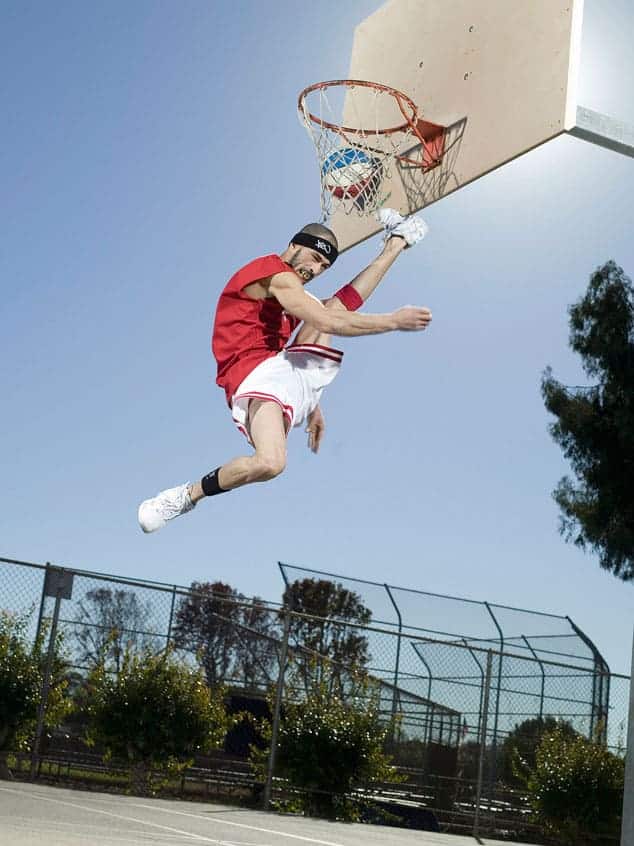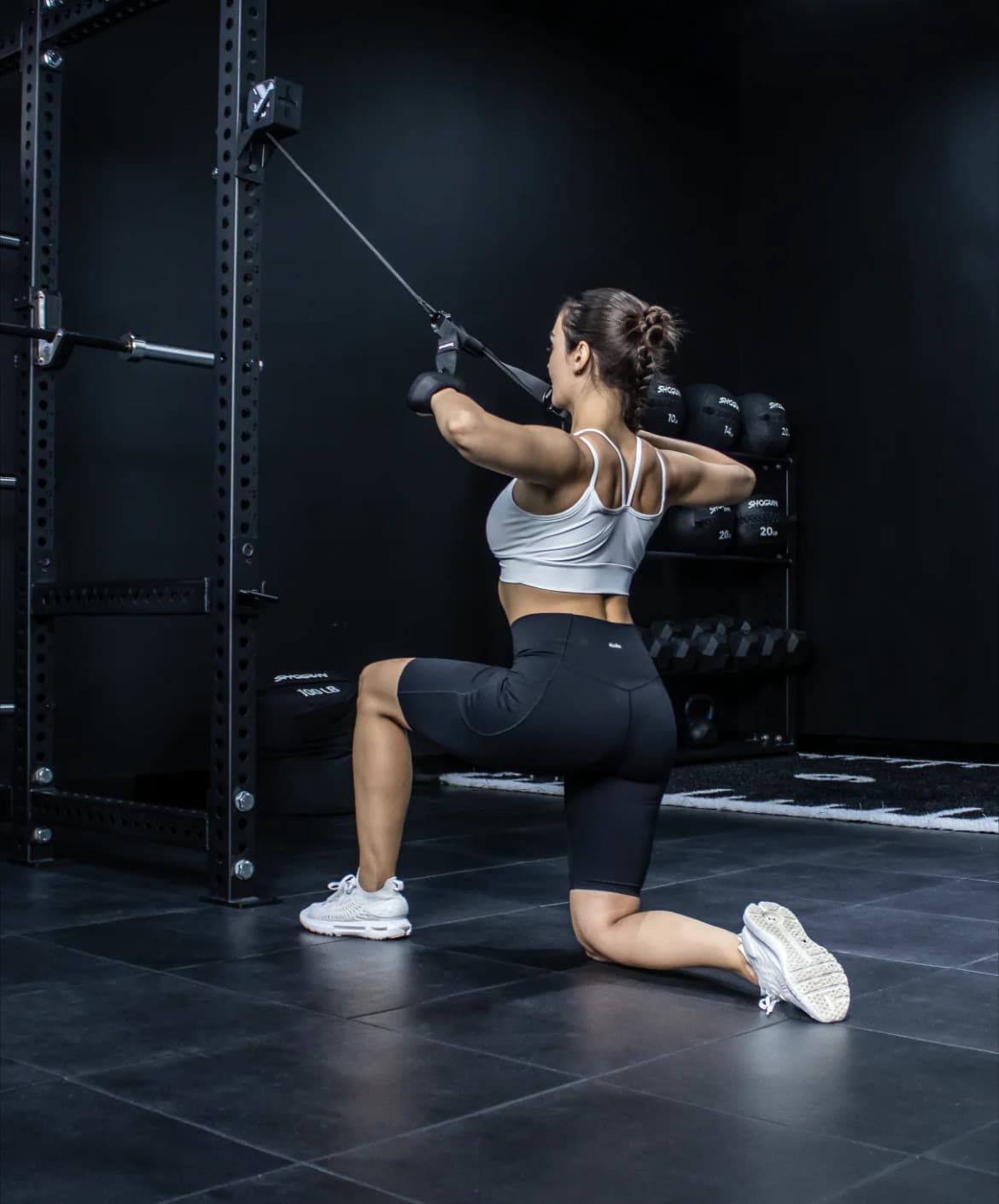Ever since I started training I’ve been extremely tight and inflexible.
I decided it was high time to start stretching far more regularly in an attempt to remedy my super tight muscles.
I’ve come up with a list of six primary lower body stretches that I now perform every single day, three times a day with the goal of fixing this chronic tightness in my legs and hips.
This article will look at why these stretches are particularly effective for those interested in vertical jump training, as well as some best practices when it comes to stretching such as frequency, duration, and impact on vertical jump.
The order of importance may be different for you, but these are the key areas you ought to be hitting regularly if you also need to improve your flexibility as a vertical jump aspiring athlete.
Having a foam roller handy is going to be really important for you to effectively complete this routine, so make sure you pick one of those up if you don’t already have one!
1. Couch Stretch
Having tight quads is a disaster because they’ll start to pull on your hips and can lead to knee pain.
Both of these things we want to avoid like the plague as jumpers.
The ‘couch stretch’ is an excellent way to restore flexibility to your quads and can be performed by pulling one of your heels to your bum and wedging your leg up against something like a couch or wall.
Having something soft to rest your knee on will make this easier too.
It’s also important to hit the side of your quad, AKA your iliotibial band which runs right up the side of your upper leg.
Also Stretch Your IT Band
If you let this muscle get too tight, you can get IT band syndrome which will cause knee pain.
Make sure you always hit your IT band when stretching your quads.
Simply use a foam roller as shown.
Find where it hurts the most and hold that position for at least 30 seconds.
You could probably roll each IT band for closer to a minute if you’re getting a lot of pain when rolling.
Make sure you start right up at the knee and roll all the way up to the hip.
I recommend using the GRID X edition foam roller.
It’s 50% firmer than the typical GRID rollers and is extra brutal, meaning you’re going to get a far superior stretch.
2. Achilles Tendon Foam Rolling
Being able to plantarflex and dorsiflex efficiently at the ankle has been connected with vertical jump prowess.https://www.mdpi.com/2411-5142/6/1/14/pdf
By foam rolling your Achilles tendon, you’re able to increase flexibility and range of motion in the lower leg which may give you a biomechanical advantage when it comes to jumping.
This is a relatively simple stretch that loosens up your Achilles and also hits the all-important flexor digitorum longus muscle that runs down the backside of your tibia.
Strengthening this toe flexor muscle has also been linked with increased vertical jump performance, so make sure you’re doing this one.https://www.researchgate.net/publication/339520075_Importance_of_toe_flexor_strength_in_vertical_jump_performance
3. Shin Stretch
Continuing on with the above, having a strong and flexible tibialis anterior is also going to lead to improved ankle dorsiflexion.
You can stretch your shins in a number of ways but one of the simplest ways is to sit on your heels and press down on your ankles as demonstrated below.
If you’re not also doing tibialis anterior specific strength work, you’re definitely leaving vertical jump gains on the table.
It’s crucial you strengthen this muscle for a number of reasons.
Be sure to check out my full article on strengthening your tibialis anterior for the vertical jump.
4. Hamstring Stretch
Any of your stock standard hamstring stretches should work fine here.
You can do these sitting down or standing with your leg up on a ledge.

If you’re anything like me and spend most of your day seated at a desk, you absolutely have to stretch your hammies!
Sitting at a desk tightens them up a lot and I always recommend stretching your hamstrings at least 2-3 times per day.
If you’re simply stretching them once in the evening or morning, they’ve completely reverted back to their prior tightness by the end of your work day and this prevents you from actually progressing on the flexibility front.
By inserting a 10 minute hamstring stretch right in the middle of your work day, you can massively reduce the adverse effects sitting at a desk all day has on your flexibility.
5. Hip Flexor Stretch
Tight hips cause all sorts of problems for jumping efficiently and also training effectively in the gym.
Personally I can’t squat without discomfort in my hips and it’s because they’re absurdly tight!
There’s plenty of variations of stretches you can do for the hip flexors, most are similar to the one shown below (the psoas is highlighted here).
It might help if you have something to hang onto while stretching your hip flexors.
I typically use a plyo box which I push myself away from which allows me to sink deeper into the stretch.
6. Glute Stretch
If you’re flexible enough, while seated, try to get one foot completely over the other knee and then hug your knee.
You should feel a deep stretch in the glute of the leg you’re hugging.
If you’re not quite that flexible, try this variation lying on your back.
That should be more manageable for those of us who are particularly inflexible!
How Long To Hold These Stretches For?
Studies have shown that 30-60 seconds seems to be the sweet spot. Holding the stretch for at least 30 seconds turned out to be significantly better than 15 seconds and not much different to holding it for 60 seconds.https://pubmed.ncbi.nlm.nih.gov/8066111/
So my recommendation is to hold each of these stretches for at least 30 seconds on each side and with that you should be able to get through the entire routine in less than 10 minutes.
If you feel like you need more than that, repeating the routine multiple times throughout the day will be more effective than holding each stretch for longer, as we’ll discuss later on.
Does Stretching Help You Jump Higher?
Stretching itself doesn’t really improve your vertical jump.
Some excellent jumpers are about as tight as I am.
Others, like Kadour Ziani for example, are extremely limber.

The research suggests there isn’t much link between flexibility and jump performance.
Being too flexible usually has a negative impact on your vertical jump, so if you’re already really flexible, don’t keep pushing it to contortionist-level flexibility otherwise you may not jump so well!
All stretching can really do is increase your mobility and range of motion in the various exercises you perform regularly when working on your vertical.
For me, improving my flexibility would mean improving my ability to squat.
Improving my squat will in turn lead to improving my vertical.
Being flexible has many other benefits, injury prevention being a major one.
How Often Should I Be Stretching To Jump Higher?
While there isn’t much data to support this claim, I’m a firm believer that stretching frequently throughout the day is far superior to stretching once per day (even if you do so for longer).
The idea being that if you’re sitting at a desk job most of the day, stretching once in the evening or morning is almost completely negated by the long period of time sat in a chair.
My recommendation is to stretch 3 times per day in order to improve flexibility.
Once in the morning, once in the middle of the day (ideally somewhere around half way through the work day), and then once more in the evening.
Of course this won’t be practical for most, but just getting a single session in should make a decent impact.
As I mentioned, the goal is simply to make you loose and limber enough to perform all the various training exercises in the gym without any discomfort.
Some people will already be at this stage and others (like me) have to work hard to overcome their relative inflexibility.
Avoid Static Stretching Before Jumping
You should only ever do these static stretches after a workout.
Or at least not directly prior to jumping, if you care about how high you jump.
Studies have demonstrated that static stretching before jumping leads to underwhelming jump performance.
The results demonstrated that static stretching has a negative influence on vertical jump performance, whereas dynamic stretching has a positive impact.https://pubmed.ncbi.nlm.nih.gov/19204571/
This is because our muscles act like an elastic band.
If you stretch a rubber band out overnight, it’s going to lose a lot of its spring.
Static stretching has the exact same effect on our muscles.
In all honesty, the only time you really won’t want to do static stretching is prior to testing your vertical jump.
I quite often still do some static stretching combined with a dynamic warm up prior to jumping, because I don’t care too much if I jump slightly lower in any given workout.
Most of the time I’m there to train, not to jump as high as humanly possible.
Another study has shown that static stretching for 30 seconds or less barely moves the needle in terms of performance and that most of the detriment to performance happens when you hold the stretch for closer to 60 seconds.https://pubmed.ncbi.nlm.nih.gov/24936897/
Be sure to read my article on the most effective way to warm up for vertical jump testing, if you’re concerned about jumping your highest in the near term.
Conclusion
Above I’ve listed the important muscle groups above that you should be stretching out regularly.
I’ve also provided some example stretches that do a great job of loosening up these muscles.
How long you stretch for and how frequently is more or less discretionary.
How flexible are you currently?
Do you have problems with tightness that affect your form on various lifts in the gym?
For someone like me who could be classified as a ‘brittle bro’, I need to be stretching for at least 30 minutes a day if I want to make any sort of progress on my flexibility.
For you it might be less than 15 minutes per day.
Some of you won’t have to really do any static stretching because it’s simply not an issue for you.
But I’d always recommend doing some form of regular stretching or foam rolling especially if you spend a long time in a seated position during the day.
If you’re looking for some more stretches, check out my article where I discuss the best stretches for ATG/knees over toes training.
























